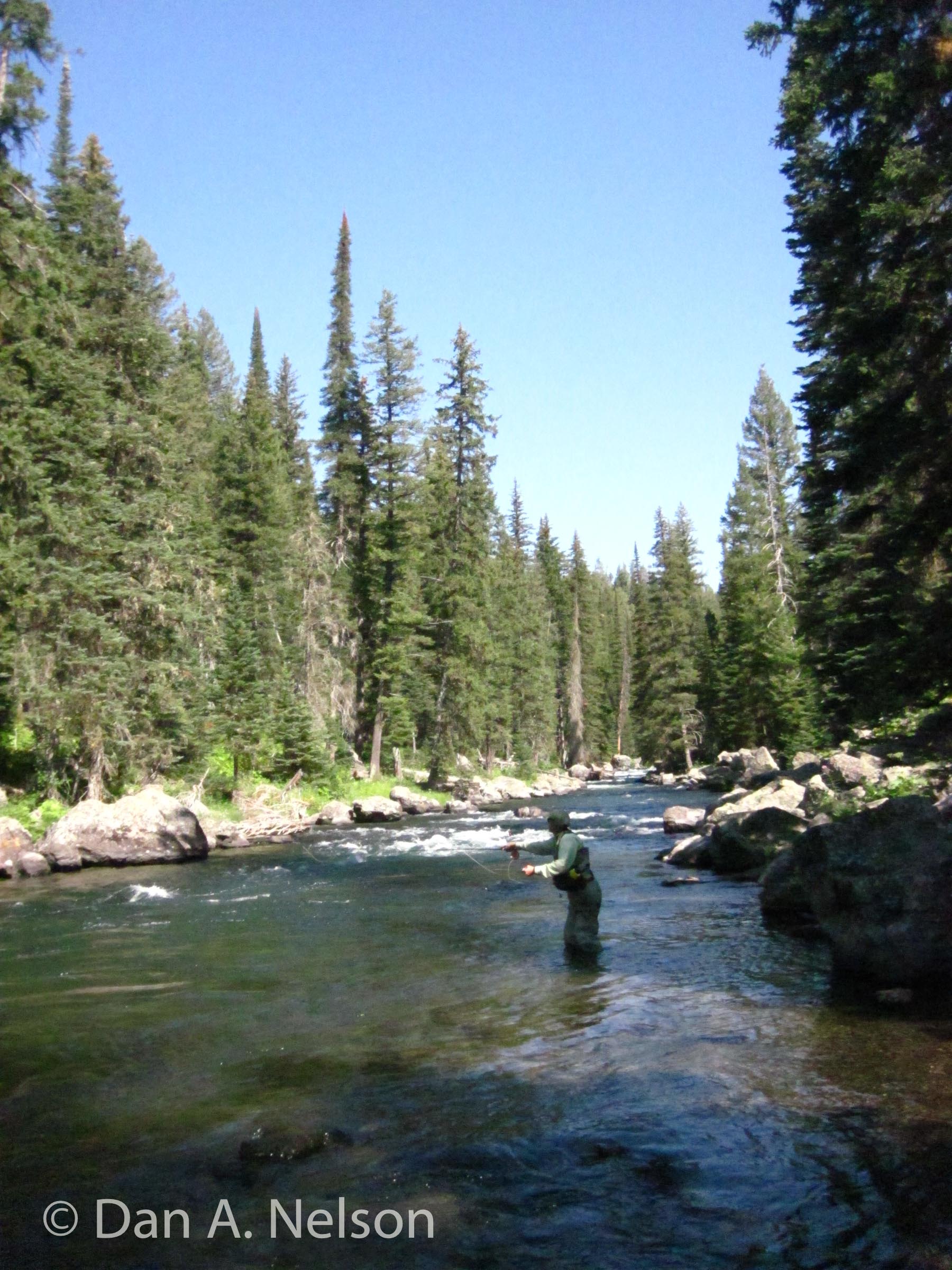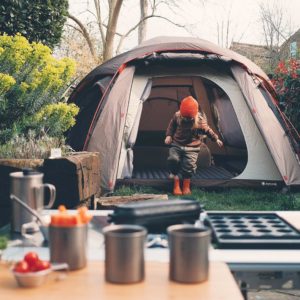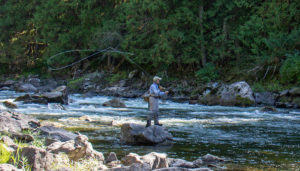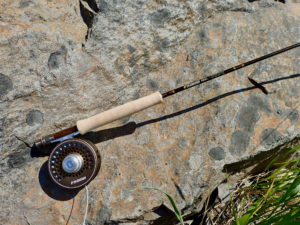Fish Camps, 21st Century Style
On the Rainbow Road: Camping near trout
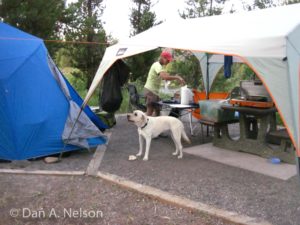
The numbers are easy. Four states. Seven rivers. Two thousand, five hundred and eighty three miles. Countless fish.
The total value of our road trip, though, can’t be measured.
For two weeks, three of us – my wife, our yellow lab, and me – drove through some of the most beautiful country and most rewarding fishing locales on the planet. With no set plans, we camped where ever and whenever we wanted. Finding suitable campsites wasn’t always easy, but since we didn’t want to stick to an itinerary, we made the best of it and generally had great campsites near fantastic fishing.
We started with a long drive east from our Western Washington home, over the Cascades via Chinook Pass and then raced along Interstates through the barren deserts of southern Washington and into northeastern Oregon. We abandoned the four-lane at LaGrande, Oregon, and headed east on State Highway 82 for a couple hours, landing in the Wallowa Lake State Park. A base camp here provided access to the Wallowa River, and the skinny water of Lostine River – a great little waders river just a half hour away. We spent a day seeking, but failing to find, fish in both the Wallowa and the Lostine. The rivers were a bit warm, we found, and the fish lethargic. The lack of hatching insects didn’t help our cause, so we simply enjoyed another evening in the lakeside campground before continuing our adventure. If we had had more time, we would have ventured up into the glorious Eagle Cap Wilderness deep in the heart of the Wallowa Mountains to our south. The town of Joseph, on the north shore of Wallowa Lake, is the gateway to that backcountry wonderland and its myriad of trout-rich alpine lakes and crystalline streams.
Instead of that wilderness trek, though, it was back to the interstate network for another long push east, cutting across southern Idaho at 75 mph. We reluctantly bypassed the renowned waters of Silver Creek at the mouth of Sun Valley, instead focusing on another Blue Ribbon destination: the Henry’s Fork of the Snake River.
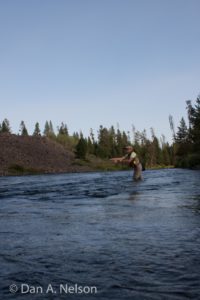 Late in the day, we established camp at Riverside Campground along the shores of Henry’s Fork and after giving Sophie a chance to swim in the river just outside camp, we rigged our rods and waded into the fabled waters just in time for a small evening hatch of pale duns. While I flailed feebly, Donna hooked up with first fish of the trip. She brought a couple fine rainbows to the net in some deep holes just upstream from camp. Riverside Campground, a US Forest Service facility, sits in the trees on the west bank of the Henry’s Fork, just south of Harriman State Park. The fishing is fair along the A-loop of the campground and better down along the B-loop. The campground boasts of several sites right alongside the river, and most of the A- and B- loop sites include new picnic tables on concrete pads, and most have smooth sand pads for tents. C-Loop is further up in the trees and its sites are a bit more rustic.
Late in the day, we established camp at Riverside Campground along the shores of Henry’s Fork and after giving Sophie a chance to swim in the river just outside camp, we rigged our rods and waded into the fabled waters just in time for a small evening hatch of pale duns. While I flailed feebly, Donna hooked up with first fish of the trip. She brought a couple fine rainbows to the net in some deep holes just upstream from camp. Riverside Campground, a US Forest Service facility, sits in the trees on the west bank of the Henry’s Fork, just south of Harriman State Park. The fishing is fair along the A-loop of the campground and better down along the B-loop. The campground boasts of several sites right alongside the river, and most of the A- and B- loop sites include new picnic tables on concrete pads, and most have smooth sand pads for tents. C-Loop is further up in the trees and its sites are a bit more rustic.
For our first full day of fishing, we stopped in at the Orvis shop at Island Park, bought a few flies to match the local hatch and sought advice on what stretches of water would be worth wading. The shopkeeper suggested several options, and we quickly decided to forgo the fabled Ranch section in Harriman Park and instead work our way down to the east bank just south of the park. We waded into this slow-moving weed-rich section with several other angles upstream of us and proceeded to experience a magnificent pale morning dun (PMD) hatch exploding around out. Several rod-bending lunkers later, we exited the river for late lunch.
That evening we caught a few more fish in the camp section while Sophie scampered through the shallows behind us. The next day we hiked into the Box Canyon section of the river for some incredible wild water fishing in a narrow gorge. We saw only one other angler and caught a plethora of rainbows in the 8- to 18-inch range.
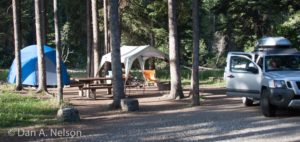 From Riverside Camp, we headed north, crossing into Montana at West Yellowstone and descending Highway 191 through the Gallatin Valley to Big Sky. We found a suitable campsite along the river in Greek Creek Campground. Indeed, this campsite would be perfect except for one thing – it, like all the campgrounds in the valley – immediately abuts the highway. The campgrounds tend to occupy narrow strips of public land between the road and the river. The problem with that: the highway is heavily used by long-haul truckers all hours of the day. The sound of semis racing by, mere yards from camp, kept our sleep light and variable. But the fishing during the day kept us wide awake!
From Riverside Camp, we headed north, crossing into Montana at West Yellowstone and descending Highway 191 through the Gallatin Valley to Big Sky. We found a suitable campsite along the river in Greek Creek Campground. Indeed, this campsite would be perfect except for one thing – it, like all the campgrounds in the valley – immediately abuts the highway. The campgrounds tend to occupy narrow strips of public land between the road and the river. The problem with that: the highway is heavily used by long-haul truckers all hours of the day. The sound of semis racing by, mere yards from camp, kept our sleep light and variable. But the fishing during the day kept us wide awake!
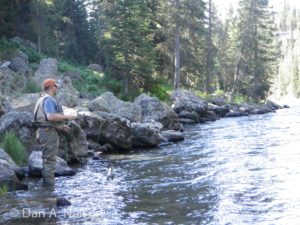 The best hole we found on the Gallatin – and we found lots of them worth exploring! – nestled just below the riffles at the bottom of the river bend immediately upstream from camp. A few minutes walk put us into water teeming with trout. Donna worked a beautiful 16-incher out from behind one boulder the first evening and got its twin the next night from a run at the apex of the bend. We hooked and released dozens of fish from that big bend during our three days in the valley.
The best hole we found on the Gallatin – and we found lots of them worth exploring! – nestled just below the riffles at the bottom of the river bend immediately upstream from camp. A few minutes walk put us into water teeming with trout. Donna worked a beautiful 16-incher out from behind one boulder the first evening and got its twin the next night from a run at the apex of the bend. We hooked and released dozens of fish from that big bend during our three days in the valley.
Three nights of truck traffic, though, proved our limit, so we packed up camp and headed north, then west. With no drift boat available, we blasted through Ennis and bypassed the mighty Madison. We arrived in Dillon several hours later – after a detour down the graveled Burma Road from Twin Bridges. The Burma Road follows alongside the Big Hole and passes a few very rustic state campgrounds. We found fish plentiful along the route – including a hungry swarm of whitefish near the first bridge at the start of Burma Road. We also disturbed a moose in that hole, but he didn’t stick around to watch us work the blue dun hatch.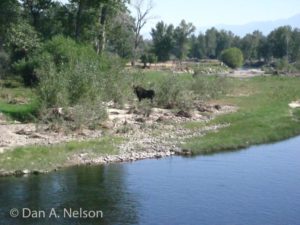
Having spent a week in state parks and forest service camps, we opted to forgo those rustic campsites along the river (and by rustic, we mean no running water – other than the river, outhouses, and dirt roads) for a few more luxuries for the next stop: the Dillon KOA. Hot showers, running water in camp, and access to three of the finest trout streams in Montana: the Big Hole, the Beaverhead, and the Ruby. The Beaverhead rolls past the KOA in Dillon, providing casting opportunities right from camp. We didn’t see or feel any fish there ourselves, but the river was running high during our stay and the local shop reported the best action on the Beaverhead would be found from a boat. So we focused on the Big Hole.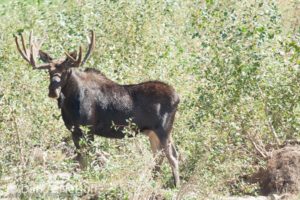
We fished holes along a 50-mile stretch of the Big Hole, from Twin Bridges to Wise River. Both Donna and I hooked up with our own personal best trout on this river – Donna near the Burma Road Bridge, and me in the Maiden Rock area. Mine was a broad-shouldered brown that went nearly two feet long and had my reel singing like a soprano on speed: fast and high!
Though the fishing was fine, the dry country around Dillon had us yearning for some true mountain time, so we packed up after four days and headed west once again. We angle a bit north, too, following Interstate 15 to I-90 all the way to Rock Creek. Fortunately, by the time we arrived the famous annual event known as the Rock Creek Testicle Festival had wrapped up, so we weren’t subjected to rowdy crowds and grills ladened with Rocky Mountain Oysters. Instead, we found a long mountain valley and cold mountain river teeming with trout.
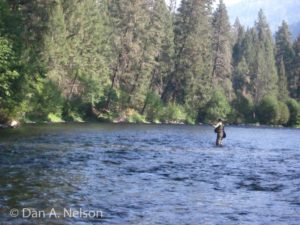 The Bitterroot Campground, 23 miles in from I-90, proved the perfect primitive camp for tent campers like us. With large sites well spaced, we were totally secluded in the small campground, with fishable water right out of camp. Full-service private camps are available closer to the freeway – the narrow, windy Rock Creek Road isn’t well suited to travel trailers or 5th wheels past the Dalles Campground at Mile 14.5, though most opt to stop at the Norton Campground at Mile 11.
The Bitterroot Campground, 23 miles in from I-90, proved the perfect primitive camp for tent campers like us. With large sites well spaced, we were totally secluded in the small campground, with fishable water right out of camp. Full-service private camps are available closer to the freeway – the narrow, windy Rock Creek Road isn’t well suited to travel trailers or 5th wheels past the Dalles Campground at Mile 14.5, though most opt to stop at the Norton Campground at Mile 11.
The river offers an array of trout species, and gets fished heavily all summer by fly fishers and gear anglers. But our early September visit still yielded several fish each day for both of us, including one “Triple Crown” day for me, with a rainbow, a brookie, and a cutthroat – each going over 12 inches – brought to hand.
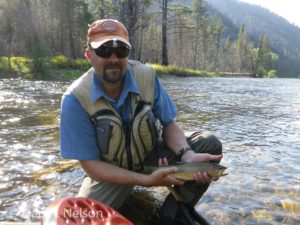 By the time the cooler was running empty, we were starting to miss home, so once again, the rugged Xterra was packed to the gills with our camp gear and we hit the road. Westward we rolled, flying fast along I-90, across the Idaho Panhandle and the dry side of Washington. As we neared the Cascades, though, we just had to pause and wet our lines once more. This time in the familiar waters of the Yakima, Washington’s only Blue Ribbon trout river. We found a few old friends in the riffles near Cle Elum. We let Sophie swim away from the road weariness in ponds alongside the river. Then we broke down our rods for the first time in two weeks and rolled west to home.
By the time the cooler was running empty, we were starting to miss home, so once again, the rugged Xterra was packed to the gills with our camp gear and we hit the road. Westward we rolled, flying fast along I-90, across the Idaho Panhandle and the dry side of Washington. As we neared the Cascades, though, we just had to pause and wet our lines once more. This time in the familiar waters of the Yakima, Washington’s only Blue Ribbon trout river. We found a few old friends in the riffles near Cle Elum. We let Sophie swim away from the road weariness in ponds alongside the river. Then we broke down our rods for the first time in two weeks and rolled west to home.
Fish Camps Around the Country
Donner Memorial State Park, Truckee, California
Fishing on the Truckee River
This diverse state park offers campers access to boating, hiking, a museum and of course fishing. Many gear and bait anglers will focus on Donner Lake, but fly fishers will do best venture down the road to the Truckee River, where they’ll find rainbows, browns and perhaps even some Lahontan cutthroat trout. The several sections of the river are stocked annually, while the native cutthroat can be found in the wilder stretches above the Boca Hills. www.parks.ca.gov
South Rim Campground, Black Canyon of the Gunnison National Park, Colorado
Fishing on the Gunnison River
Colorado offers a host of great trout waters, but the Black Canyon of the Gunnison provides a unique blend of wild, scenic beauty; wild, native trout; and national park protections. The South Rim Campground is the park’s largest camp (89 spaces), and only one that offers electrical hook-ups and year-round camping. Rainbow and brown trout fill the Gold Medal River, and selective gear rules (i.e. fly fishing only with single barbless hook) ensures the fishery remains strong and productive. www.nps.gov/blca/
Hartwich Pines State Park, Michigan
Fishing on the Au Sable River
This campground provides anglers with four ponds and the Au Sable River – the classic trout river of the Mid-West. The Campground sits within a state park covering nearly 10,000 acres, so non-fishing family members can hike or bike miles of forest trails, explore the on-site museum, or bird watch amongst the ancient grove of old growth pines in the heart of the park. Fish the East Fork Au Sable right from camp, or head a few miles southeast to find the fly-fishing only section of main stem of the Au Sable starting at Burton’s Landing, located just a few miles east of the City of Grayling. www.michigandnr.com
Camping on the Battenkill. Arlington, Vermont
Fishing on the world-famous Battenkill
This privately owned campground caters to families, but anyone will appreciate the quiet environment of the park-like setting on the shores of New England’s most famous trout water. The Battenkill flows through the campground property, so anglers can wet a line just a short walk away from their campsite. There are also sections of the river that don’t lend themselves to angling, but are ideal for family swimming. www.campingonthebattenkillvt.com
BOOKS:
Montana’s Best Fly Fishing: Access, and Guides’ Advice for the State’s Premier Rivers by Ben Romans.
One of the best fishing guidebooks we’ve found. Romans provides detailed river descriptions, with specific call-outs on wading and floating sections, what flies to use, and recommendations from local guides and shop owners. Other titles in this series cover Colorado and California. List price is $29.95. http://www.stackpolebooks.com
